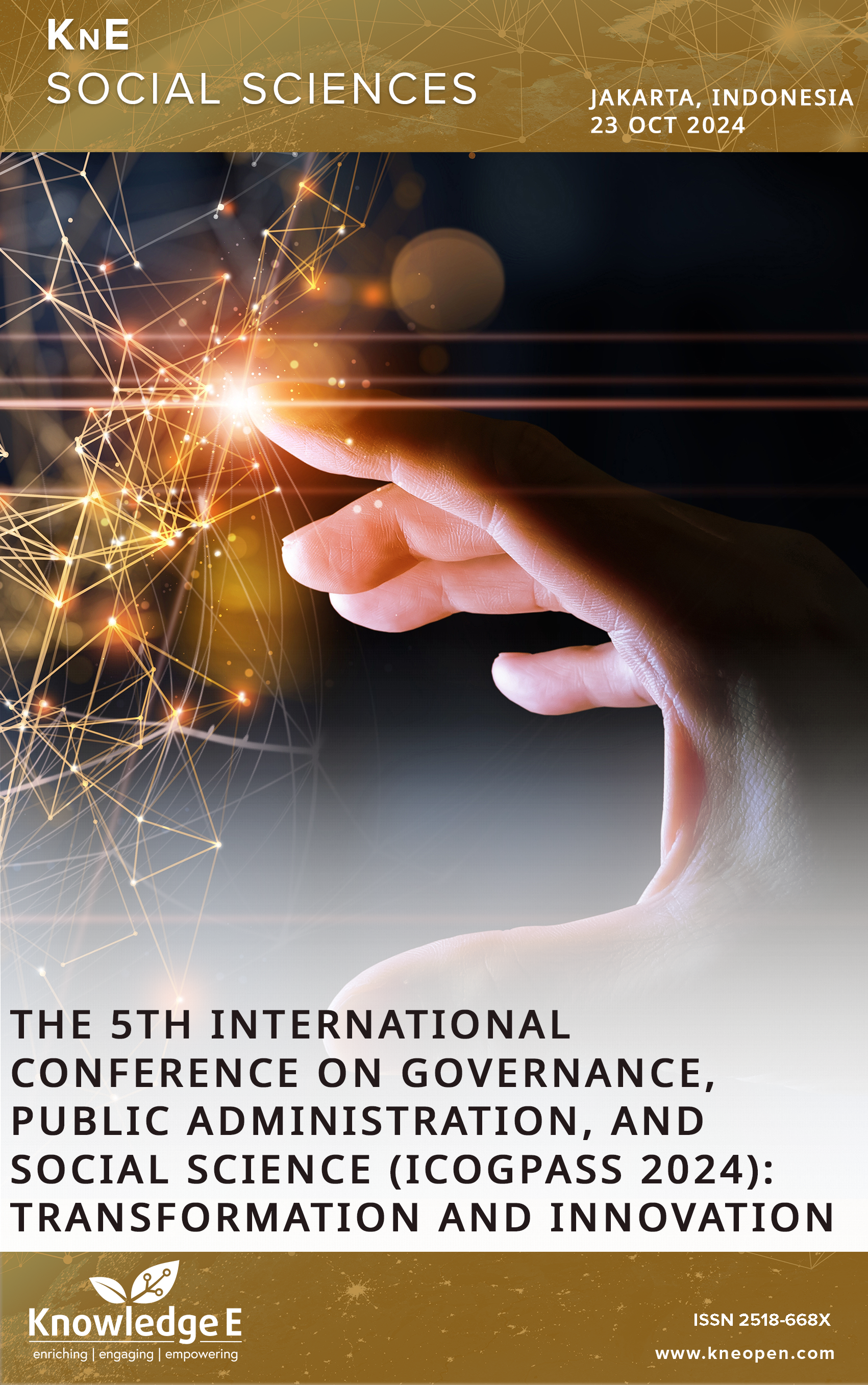Digital Governance in the Local Government of Sumedang Regency
DOI:
https://doi.org/10.18502/kss.v10i16.19181Keywords:
digital governance, government policies, implementation standards, human resources stakeholder involvementAbstract
The study’s objective was to examine the implementation of digital governance in Sumedang Regency, focusing on government policies, digitalization implementation standards, and human resources and stakeholder involvement in digitalization implementation. This study applied a qualitative approach with data collection techniques through literature studies and interviews. The study results showed that Presidential Regulation No. 95 of 2018 concerning the Electronic-Based Government System (SPBE) serves as the main foundation for implementing digitalization in local governments, followed by other policies from the Sumedang Regency government. Digitalization in the Sumedang Regency Government is also supported by IT staff recruited to develop the information system. International standards such as ISO 27001 and ISO 9001 are applied to ensure the security and quality of the digital systems being developed. Stakeholder involvement, such as Telkomsel, Telkom University, and the community, strengthens the digitalization process through effective collaboration. In addition, the continuous development of human resource capacity is key to maintaining the success of digital transformation. The conclusion of this study emphasized that multi-stakeholder collaboration and continuous human resource development are key to the success of creating a more efficient and responsive government to the needs of the people in Sumedang Regency.
References
[1] (2005) , G.-G. dan P. (2005) ‘E-Government Success factor: Mapping practical tools to theoretical foundations’, Government Information Quarterly, pp. 187–216.
[2] Ansell C, Gash A. Collaborative governance in theory and practice. J Public Adm Res Theory. 2008;18(4):543–71.
[3] Aprilinda Y, Puspa AK, Affandy FN. The Use of ISO and COBIT for IT Governance Audit. J Phys Conf Ser. 2019;1381(1):012028.
[4] Bertot JC, Jaeger PT, Grimes JM. Using ICTs to Create a Culture of Transparency: Egovernment and Social Media as Openness and AntiCorruption Tools for Societies. Gov Inf Q. 2010;27(3):264–71.
[5] Charliyan A. Development of Electronic Governance Based Regional Government Management. Jurnal Multidisiplin Sahombu. 2023;3(01):54–60.
[6] David A, Yigitcanlar T, Li RY, Corchado JM, Cheong PH, Mossberger K, et al. Understanding Local Government Digital Technology Adoption Strategies: A PRISMA Review. Sustainability (Basel). 2023;15(12):1–43.
[7] Ester L, et al. Pengaruh Aspek-aspek Sumber Daya Manusia Terhadap Kinerja Pekerja Pada Perusahaan Konstruksi Di Kabupaten Manokwari. 2023;12(1):158–65.
[8] Estevez E, Janowski T. Electronic Governance for Sustainable Development - Conceptual framework and state of research. Gov Inf Q. 2013;30 SUPPL. 1:94–6.
[9] Headayetullah, M. and G.K, P. Interoperability, Trust Based Information Sharing Protocol and Security: Digital Government Key Issues. Int J Comput Sci Inf Technol. 2010;2(3):72–91.
[10] Hong SG, Lee DH. Development of a citizen participation public service innovation model based on smart governance. Serv Bus. 2023;17(3):669–94.
[11] Keban YT. (2004) Enam Dimensi Strategis Administrasi Publik: Konsep. In Teori dan Isu. Gaya Media.
[12] Kusdinar R, Satibi I. Strategy for Making E-Office Service Policy Transformation Effective in the New Order Period at the Regional Secretariat of Sumedang Regency. Central European Management Journal. 2023;31:120–5.
[13] Mensah IK, Adams S, Adjei JK, Mwakapesa DS. Drivers of egovernment adoption amidst COVID-19 pandemic: The Information Adoption Model (IAM) approach. Inf Dev. 2022;38(4):494–509.
[14] Mokuolu OA, Bolarinwa OA, Opadiran OR, Ameen HA, Dhorda M, Cheah PY, et al. A framework for stakeholder engagement in the adoption of new anti-malarial treatments in Africa: a case study of Nigeria. Malar J. 2023 Jun;22(1):185.
[15] Moon MJ, Norris DF. Does Managerial Orientation Matter? The Adoption of Reinventing Government and E-Government at the Municipal Level. Inf Syst J. 2005;15(1):43–60.
[16] Noorman MA, de Wit JB, Marcos TA, Stutterheim SE, Jonas KJ, den Daas C. The Importance of Social Engagement in the Development of an HIV Cure: A Systematic Review of Stakeholder Perspectives. AIDS Behav. 2023 Nov;27(11):3789–812.
[17] Padilla, L. (2023) ‘The Health Resources and Services Administration – Bureau of Health Workforce Response to the COVID-19 Pandemic’. https://doi.org/10.1177/00333549231172555.
[18] Personal, M. and Archive, R. (2008) ‘Munich Personal RePEc Archive ICT Governance : Towards Federalized Structure and Solution’, (12365).
[19] Roundtable DG. Government As a Digital Disruptor. 2014;19(2):49–54.
[20] Tahir MI, Hendiyani MF, Maryani D, Kartika DI. Implementation Information Technology Governance in Licensing Service At Sumedang Regency. Sosiohumaniora. 2022;24(3):371.
[21] Vlcek S, Somerton M, Vlcek S. Collaborative engagement between stakeholders in the education of Australian students with disability : a scoping review review. Int J Incl Educ. 2023;0(0):1–18.
[22] West, J. 2004. (2004) ‘Interaction of energy and bovine somatotropin with heat stress.’
[23] Zhang T, Jiang J, Li S. Research and Application of Governance System Development of Digital Government. Advances in Economics and Management Research. 2023;5(1):34.
Published
How to Cite
Issue
Section
License
Copyright (c) 2025 Andi Wa Ode Suastina, Nurman Sahar

This work is licensed under a Creative Commons Attribution 4.0 International License.

